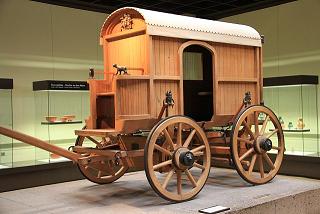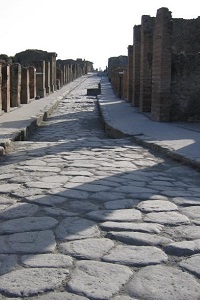Roman carriages
Ancient Romans used Roman carriages and other forms of transportation the most basic one being walking! Walking was actually the most common way of moving around and carriages would mostly be used to transport goods or to travel long distances.Roman carriages had iron-shod wheels (they did not have rubber then) which means that they made a lot of noise! Carriages were forbidden in big cities such as Rome during the day, therefore residents had to bear the sound of their wheels at night.
Everyday Roman carriages
The plaustrum was one of the most common vehicles in Rome. It was mostly used to transport construction materials or agricultural goods such as cereals, olive oil, wine, etc. It was the equivalent of our trucks today. It was made of a wooden board with two to four thick solid iron-shod wheels. It usually had no top and no sides. It was usually drawn by two oxen which had a lot of power.The essedum was a small chariot with two wheels with no top and a closed front, for two passengers standing up. Pulled by one or many horses or mules, it was rather fast. The cisium was not as fast. It also had two wheels, no top, a seat for two passengers and was drawn by one or two mules or horses. It was driven by the equivalent of a taxi driver today or by the passenger himself.
The raeda was the equivalent of our buses today. It had four wheels, many benches and space for luggage. The weight of the luggage could not exceed 1,000 Roman Libra (circa 330 kilograms) based on Roman law. It either had no top or just a clothed top. It was drawn by many oxen, mules or horses, sometimes up to four hourses and even more mules!
Surprisingly Romans did not generally use horses for travel. They did not have all the equipment that we have today like the stirrup in order to have a stable and comfortable ride.

Carpentum replica at the Cologne Museum |
Transportation of the wealthy
Wealthy Romans and especially wealthy Roman women would use a litter (either owned or rented) to go around the city or to go on very short trips. Six slaves (bearers) would carry one or two persons who reclined in the litter. Wealthy women would use the litter often in order to avoid contact with working class Romans. Bear in mind that city streets were not always safe especially for attractive wealthy women.
The carpentum was the bus or limousine of wealthy Romans. It had four wheels, a wooden arched rooftop and was pretty comfortable, spacious and nicely decorated inside. The carruca was like a smaller carpentum. Again it was usually used by wealthy Romans and could accommodate two passengers. Both the carpentum and carruca has some kind of suspension and metal and leather straps which made the ride more comfortable.
Time of travel in ancient Rome
Travel in Roman times was slow and... exhausting. According to ORBIS, the Google Maps for the ancient world developed by Stanford University, it took six days to go from Rome to Naples vs. about 2 hours and 20 minutes today (source: Google Maps). Because carriages often lacked suspension, they were quite uncomfortable, making travel on the paved Roman roads very tiring. Roman carriages also made a lot of noise due to their iron-shod wheels and could be heard at night as they were forbidden from big Roman cities and their vicinity during the day.
Roman rested at way stations called mansiones or "staying places" in Latin or the equivalent of our highway rest areas today. These mansiones were built at regular intervals (15 to miles part or 25 to 30km) on Roman roads and had restaurants and pensions were Romans (and their horses) could drink, eat and sleep. They could be quite unsafe as they were often badly frequented with prostitutes and thieves looking to steal from travelers.
The fastest way to travel in ancient Rome was by horse relay called the cursus publicus. The cursus publicus was a state-run postal service similar to the poney express in the US in the 1800's which was also used to transport government officials (e.g. military officials, magistrates, etc). In order to use this service, government officials had to have a certificate issued by the emperor. The cursus publicus consisted of a series of stations along the major road systems placed at short regular intervals (of approximately 8 miles or 12 km) with fresh and rapid horses.
Historians' estimates regarding how fast travel was using the cursus publicus vary. In a study called "The speed of the Roman Imperial Post" by A.M. Ramsey (Journal of Roman Studies) time of travel on a typical trip is estimated at 41 to 64 miles per day (66-103 km per day). Therefore, a trip from Rome to Naples using the cursus publicus was approximately two days.
Various modes of land transportation in Ancient Rome
| Transportation type | ||||
| Pedestrian | 12 - 16 | Human legs. | Many | |
| Litter | 1-3 | Six slaves would carry the litter usually around the city. | Used for traveling short distances. | |
| Horse | 30-35 | Horse. | Transportation of one or two people. | |
| Plaustrum | 10 - 15 | Wooden board. No top. Two or four thick solid wheels. Sides or no sides. Drawn by oxen, usually two. | Transportation of (heavy) goods. | |
| Essedum | 25-30 | Small chariot with opened top and closed front, for two passengers standing up. Pulled by one or many horses or mules. | Transportation of persons (and sometimes goods). | |
| Cisium | 25-30 | No top, a seat for two passengers sitting. Two wheels. Drawn by one or two mules or horses. Driven by taxi drivers. | Transportation of persons | |
| Raeda | 20-25 | No top or clothed top. Many benches for many passengers. Four wheels. Drawn by many oxen, mules or horses. Driven by the raedarius. | Transportation of persons | |
| Carpentum | 20-25 | Arched top (often wooden). Four wheels. Drawn by mules or horses. | Transportation of (wealthy) persons. | |
| Carruca | 20-25 | Arched top (often wooden). Four wheels. Drawn by mules or horses, usually two. | Transportation of two (wealthy) persons. | |
| Cursus clabularis | 20-25 | Top made of cloth. Four wheels. Drawn by oxen, mules or horses. | Transportation of military equipment. |
Interesting facts about Roman carriages
|
SOURCES
- A Drive Through Time: Carriages, Horses, & History (G. Austin, CreateSpace Independent Publishing Platform, 2014).
- ORBIS The Stanford Geospatial Network Model of the Roman World (Watler Scheidel, Elijah Meeks).
- The speed of the Roman Imperial Post (A.M. Ramsey, Journal of Roman Studies).
YOU MAY ALSO LIKE
Return from Roman Carriages to Homepage
